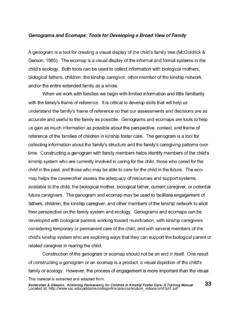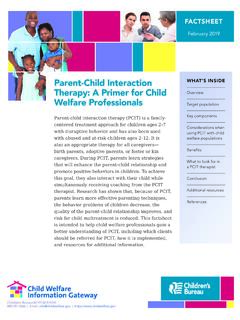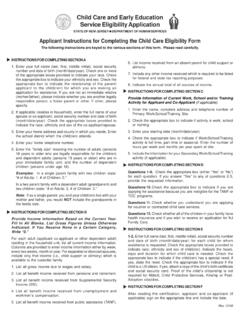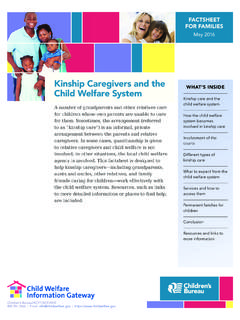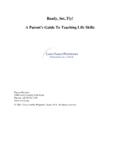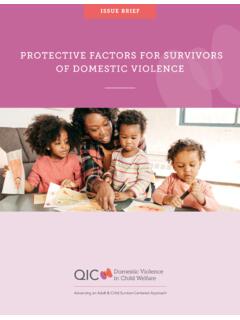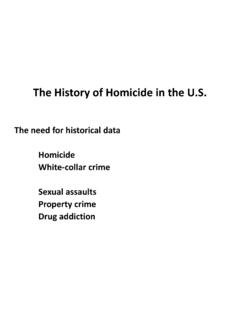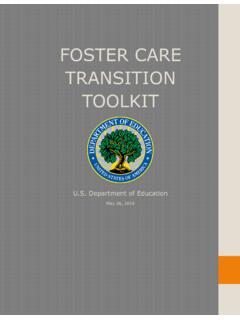Transcription of Genograms and Ecomaps: Tools for Developing a Broad View ...
1 Bonecutter & Gleeson, Achieving Permanency for Children in kinship Foster Care: A Training Manual33 Genograms and Ecomaps: Tools for Developing a Broad View of Family A genogram is a tool for creating a visual display of the child s family tree (McGoldrick &Gerson, 1985). The ecomap is a visual display of the informal and formal systems in thechild s ecology. Both Tools can be used to collect information with biological mothers,biological fathers, children, the kinship caregiver, other member of the kinship network,and/or the entire extended family as a whole. When we work with families we begin with limited information and little familiaritywith the family's frame of reference.
2 It is critical to develop skills that will help usunderstand the family's frame of reference so that our assessments and decisions are asaccurate and useful to the family as possible. Genograms and ecomaps are Tools to helpus gain as much information as possible about the perspective, context, and frame ofreference of the families of children in kinship foster care. The genogram is a tool forcollecting information about the family's structure and the family's caregiving patterns overtime. Constructing a genogram with family members helps identify members of the child'skinship system who are currently involved in caring for the child, those who cared for thechild in the past, and those who may be able to care for the child in the future.
3 The eco-map helps the caseworker assess the adequacy of resources and support systemsavailable to the child, the biological mother, biological father, current caregiver, or potentialfuture caregivers . The genogram and ecomap may be used to facilitate engagement offathers, children, the kinship caregiver, and other members of the kinship network to elicittheir perspective on the family system and ecology. Genograms and ecomaps can bedeveloped with biological parents working toward reunification, with kinship caregiversconsidering temporary or permanent care of the child, and with several members of thechild's kinship system who are exploring ways that they can support the biological parent orrelated caregiver in rearing the child.
4 Construction of the genogram or ecomap should not be an end in itself. One resultof constructing a genogram or an ecomap is a product, a visual depiction of the child'sfamily or ecology. However, the process of engagement is more important than the visualThis material is extracted and adapted from: Located at: Bonecutter & Gleeson, Achieving Permanency for Children in kinship Foster Care: A Training Manual34depiction of the genogram or the ecomap. Asking questions, probing, and generalinformation gathering in this process can be experienced as an unwelcome intrusion into aperson's life and can undermine the development of trust.
5 Questioning should be donesensitively, using good interviewing skills. When the questioning is perceived as relevantto what the person is interested in or concerned about, trust, engagement, and cooperationare promoted. Therefore, the timing and focus of Developing Genograms and ecomapsmust relate to the current case situation and in some way to the child's safety, permanency,or well-being. Families and their environments change over time. A family's genogram or eco-map may accurately depict the family and its environment at one point in time. Weeks ormonths later there may be changes in the family's structure or environment that reduce theaccuracy of the genogram or ecomap.
6 Genograms and ecomaps should be viewed asdynamic Tools that should be updated or re-created over time. Comparing Genograms orecomaps constructed with the same family at two points in time allows usefulcomparisons, highlighting changes that the family has experienced in its structure, supportsystems, and ecology. It is also unlikely that two members of the family will perceive thefamily and its ecology in the same way. Therefore, it is likely that a genogram and eco-map constructed with a child's biological parent will look different from those constructedwith the same child's maternal grandmother. The genogram is a format for drawing a family tree and displaying familyinformation, usually over three or more generations (McGoldrick & Gerson, 1985).
7 Genograms are best developed with families over several meetings. Like families, theirgenograms are dynamic, changing over time. Therefore, a genogram that presents anaccurate picture of a family today, may not be a very accurate depiction of that family a fewmonths later. Common symbols for constructing a genogram are contained in figure I-L. The genogram records, organizes, and displays a great deal of information. Muchof this information is sensitive and may elicit a range of emotions from family members. The genogram can be a useful engagement tool, helping families share sensitive andhistorical information. Genuine interest in the family s history, strengths, and child-rearingThis material is extracted and adapted from: Located at: Bonecutter & Gleeson, Achieving Permanency for Children in kinship Foster Care: A Training Manual35patterns over generations can be helpful in engaging families to tell their story.
8 While it isnecessary to ask families to describe situations that brought them to the attention of thechild welfare system, it is also important to ask them to describe how they have dealt withsimilar situations in the past, searching for successful coping mechanisms available to thefamily. For some families, moving too quickly to collect information about three generationsof the family may be viewed as prying for information that is private and not applicable tothe caseworker s role. It is wise to look for "natural" openings to obtain the informationneeded, linking questions to specific tasks that are clear to the family.
9 When sufficientlevels of trust are established it will be easier to explore issues such as previous couplingrelationships and marriages that are relevant to protection, permanency, or well-being ofthe is important to ask questions in a way that allows families to define theiruniqueness. Ask not only "who is in the family," "who lives in the home," but also ask ifthere are significant family members who live elsewhere. A follow up to this would be toask if family members have lived at various times with different members of the extendedfamily and the circumstances surrounding these moves. This practice recognizes theextended nature of the family system and creates opportunities for family members todiscuss informal adoptions and other caregiving patterns that may be components of theirkinship network s coping material is extracted and adapted from: Located at: Bonecutter & Gleeson, Achieving Permanency for Children in kinship Foster Care: A Training Manual36 This material is extracted and adapted from: Located at: Bonecutter & Gleeson, Achieving Permanency for Children in kinship Foster Care.
10 A Training Manual37 While the genogram is a particularly useful tool for creating a visual depiction of thefamily structure and caregiving patterns across generations, the ecomap is particularlyuseful for creating a visual depiction of the family s relationship with its externalenvironment. The ecomap represents the family in relationship to other formal andinformal systems that are part of the family s eco-system. An ecological assessmentexamines the family s relationship to its environment, the family-environment boundary, andthe relationship between individual family members and the environment (Hartman, 1989). The ecomap is helpful in assessing the family s strengths, needs, resources, and resourcedeficits.
